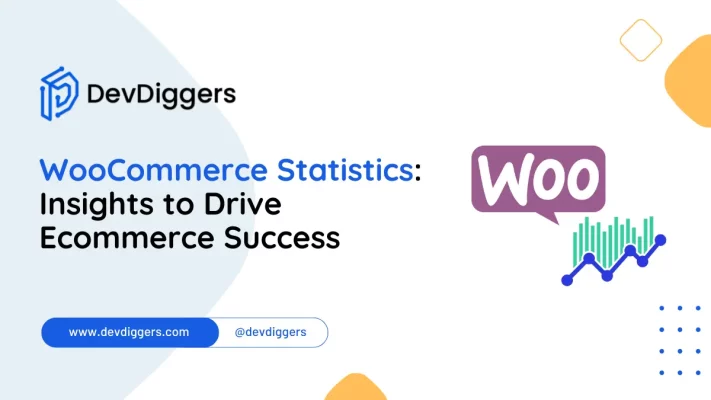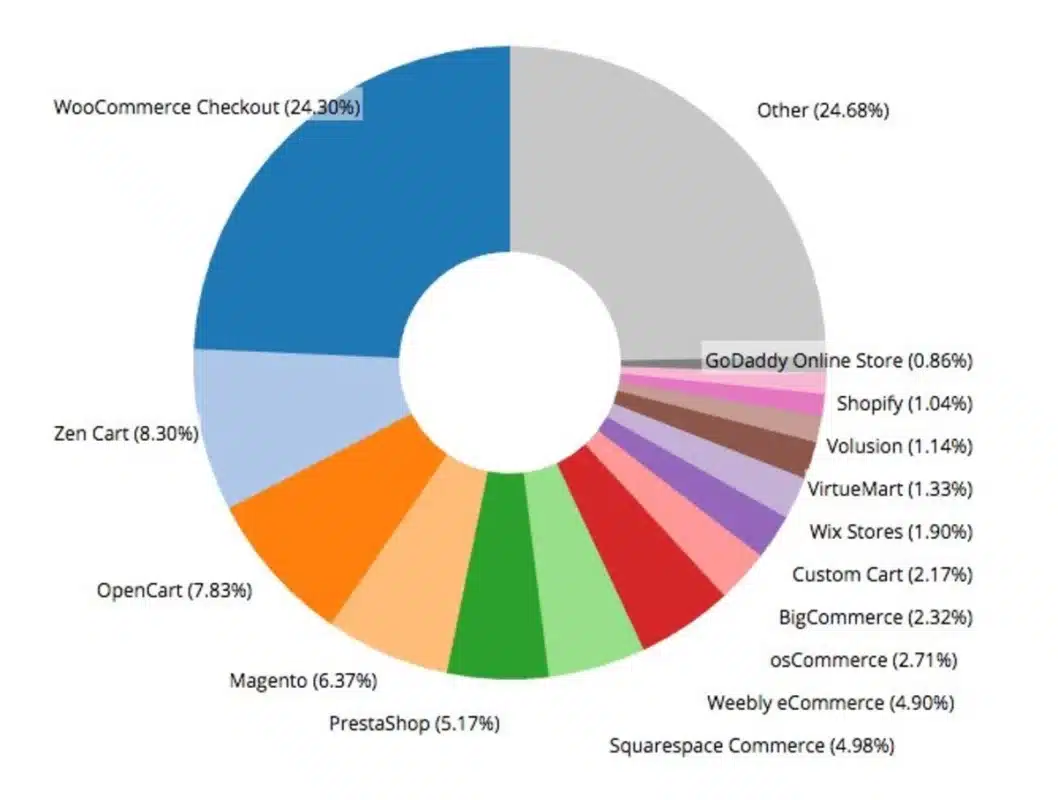WooCommerce Statistics: Insights to Drive Ecommerce Success

In the rapidly evolving world of eCommerce, WooCommerce has emerged as a powerhouse, enabling businesses of all sizes to create and manage their online stores easily.
As the go-to plugin for WordPress users, WooCommerce offers a strong platform for selling products and services backed by many features and customization options.
Understanding WooCommerce statistics is crucial for gaining valuable insights into eCommerce landscape trends.
From its market share and user demographics to sales performance and popular extensions, WooCommerce statistics paint a vivid picture of why this platform continues to dominate the online retail scene.
Join us as we look into the latest data and uncover the secrets behind WooCommerce’s success.
Table of Contents
Why WooCommerce Is So Popular?

WooCommerce has become a leading choice for eCommerce due to several key factors:
- User-Friendly Interface: WooCommerce is designed to be straightforward, allowing even those without advanced technical skills to set up and manage an online store. Its seamless integration with WordPress, which powers a significant portion of the internet, makes it a natural choice for many users.
- Highly Customizable: Offering extensive customization options, WooCommerce enables users to personalize their online stores. With a vast array of themes and plugins, businesses can create a unique shopping experience that meets their specific needs, covering everything from product displays to payment and shipping methods.
- Cost-Effective Solution: The core WooCommerce plugin is free, and many additional plugins and themes are free or available at a reasonable cost. This affordability makes it an attractive option for businesses of various sizes, from startups to large enterprises.
- Strong Community and Support Network: As an open-source platform, WooCommerce benefits from a large and active community. This community provides valuable resources such as tutorials, forums, and dedicated support, helping users to solve problems and enhance their stores.
- Scalability: WooCommerce is built to grow with businesses. It can efficiently handle a small inventory or scale up to accommodate thousands of products, making it suitable for companies at any growth stage.
- SEO Benefits: WooCommerce uses WordPress’s strong SEO capabilities, helping businesses improve their search engine rankings. This is essential for driving organic traffic to online stores.
- Integration with Third-Party Services: WooCommerce easily integrates with various third-party tools and services, including payment gateways like PayPal and Stripe, email marketing services, and accounting software. This simplifies managing multiple aspects of an online business.
- Regular Updates and Security: WooCommerce is consistently updated to enhance functionality and security. These updates ensure that the platform remains up-to-date with the latest eCommerce trends and technological developments while protecting user data.
- Global Reach: WooCommerce supports multiple languages and currencies, Making it ideal for businesses looking to operate internationally. Its ability to adapt to various regional requirements helps businesses expand their reach globally.
In summary, WooCommerce’s ease of use, flexibility, affordability, and strong support system make it a preferred platform for many eCommerce businesses.
Historical Growth of WooCommerce
The historical growth of WooCommerce is a testament to its evolution from a simple eCommerce plugin to a dominant force in the online retail space. Here’s a detailed look at its journey, highlighting key WooCommerce statistics along the way:
Early Beginnings
- 2011: Launch WooCommerce was launched in September 2011 by WooThemes, a company specializing in WordPress themes. It was created as a free WordPress plugin designed to provide a comprehensive eCommerce solution for businesses of all sizes.
- Initial Adoption The plugin quickly gained traction due to its ease of use, flexibility, and seamless integration with WordPress. Early adopters appreciated the ability to transform their WordPress sites into fully functional online stores without extensive technical knowledge. By the end of 2011, WooCommerce statistics showed significant user adoption, setting the stage for future growth.
Rapid Growth and Expansion
- 2012-2014 – Feature Expansion: Over the next few years, WooCommerce saw rapid development and increased features. The WooThemes team continually updated the plugin to include more functionalities, such as additional payment gateways, shipping options, and enhanced customization capabilities. WooCommerce statistics from this period indicated a growing user base, reflecting its increasing popularity.
- 2015 – Acquisition by Automattic: A significant milestone in WooCommerce’s history was its purchase by Automattic, the parent company of WordPress.com, in May 2015. This move brought increased resources and support, enabling even faster development and integration with the broader WordPress ecosystem. Post-acquisition WooCommerce statistics revealed a surge in downloads and installations.
Consolidation and Market Dominance
- 2016-2018—Enhanced Integrations and Scalability: After Automattic acquired WooCommerce, it grew in popularity. Automattic focused on improving the plugin’s scalability and performance, making it more suitable for larger online stores. New integrations with major payment gateways, marketing tools, and shipping solutions were introduced, further broadening its appeal. WooCommerce statistics during this period showed a significant increase in large-scale implementations.
- 2017 – WooCommerce 3.0 “Bionic Butterfly”: The release of WooCommerce 3.0 marked a significant upgrade, featuring a new product gallery, improved performance, and better management tools. This update solidified WooCommerce’s reputation as an effective and reliable eCommerce solution. WooCommerce statistics highlighted increased user satisfaction and engagement following the update.
Recent Developments and Future Prospects
- 2019-2020 – Market Expansion and Community Growth: WooCommerce’s community continued to expand, with more developers contributing plugins and themes. By this time, WooCommerce had become the most popular eCommerce platform on the web, powering millions of online stores. The plugin’s adaptability to different markets and industries was key to this growth. WooCommerce statistics from this era showed it commanding a significant share of the eCommerce market.
- 2021-Present – Innovation and Modernization: In recent years, we have focused on enhancing the user experience with features like WooCommerce Payments, a built-in payment processing solution, and WooCommerce Shipping, simplifying shipping management. The platform has also prioritized mobile responsiveness and performance improvements. Current WooCommerce statistics continue to show effective growth and widespread adoption.
- Continued Evolution: WooCommerce remains committed to innovation, regularly releasing updates to improve functionality, security, and user experience. The plugin’s roadmap includes deeper integration with WordPress features, enhanced analytics, and more powerful tools for merchants to grow their businesses. WooCommerce statistics project continued growth and dominance in the eCommerce sector.
Understanding WooCommerce Statistics
Understanding WooCommerce statistics provides valuable insights into the performance and impact of the WooCommerce eCommerce platform. Here’s a breakdown of key metrics and what they signify:
- Installation and Active Users: This metric tracks the number of installations of the WooCommerce plugin and the active users utilizing it. It reflects the platform’s popularity and adoption rate among website owners.
- Downloads and Updates: The number of downloads and updates indicates the frequency with which users install or update the WooCommerce plugin. It reflects ongoing user engagement and the development team’s responsiveness to user feedback.
- Market Share: WooCommerce’s market share compares its usage to other eCommerce platforms. A higher market share signifies a more significant presence in the eCommerce industry and a more significant influence over online retail transactions.
- Sales Volume: Tracking the total sales volume processed through WooCommerce provides insights into the platform’s contribution to eCommerce revenue. It reflects its effectiveness in facilitating transactions and generating revenue for online businesses.
- Average Order Value (AOV): AOV measures the average amount customers spend per order on WooCommerce-powered websites. It indicates customers’ purchasing behavior and helps businesses optimize pricing and marketing strategies.
- Conversion Rate: The conversion rate measures the percentage of website visitors who complete a desired action, such as purchasing, after interacting with a WooCommerce-powered site. A higher conversion rate signifies effective marketing, user experience, and product offerings.
- Retention Rate: The retention rate measures the percentage of customers who return to make additional purchases on a WooCommerce-powered site. A high retention rate indicates customer satisfaction, loyalty, and the effectiveness of retention strategies.
- Traffic Sources: Analyzing traffic sources reveals where visitors to WooCommerce sites originate from, such as organic search, paid advertising, social media, or referrals. It helps businesses understand the effectiveness of marketing channels and allocate resources accordingly.
- Cart Abandonment Rate: The cart abandonment rate measures the percentage of visitors who add items to their shopping carts but do not complete the checkout process. It highlights potential friction points in the purchasing journey and opportunities for optimization.
- Customer Satisfaction: Customer satisfaction metrics, such as ratings, reviews, and feedback, provide insights into the overall user experience on WooCommerce-powered sites. Positive feedback indicates satisfaction with the platform and encourages repeat business.
Understanding these WooCommerce statistics empowers businesses to make data-driven decisions, optimize their online stores for better performance, and maximize their success in the competitive eCommerce landscape.
WooCommerce Current Market Share

WooCommerce is the world’s largest eCommerce platform, with a 39% market share. This is predictable, considering WordPress’s popularity.
Squarespace Online Stores comes in second with 14.95%, followed by Woo Themes (14.67%).
How Many Websites Use WordPress?
As of 2024, by understanding WooCommerce Statistics. WooCommerce is used by over 6.3 million websites globally.
This figure underscores WooCommerce’s status as one of the most popular e-commerce platforms in the world.
Additionally, approximately 8.6% of all websites on the internet use WooCommerce as their eCommerce solution, which translates to about 161.6 million websites, considering the vast number of websites worldwide.
This extensive usage highlights WooCommerce’s widespread adoption and versatility in powering online stores of all sizes.
WooCommerce vs Competitors
WooCommerce is a leading eCommerce platform, competing with several key rivals. Here’s a comparison of WooCommerce statistics against its primary competitors:
WooCommerce Statistics
- Market Share: WooCommerce powers about 39% of all online stores globally.
- User Base: Over 6.3 million websites use WooCommerce.
- Integration: Seamlessly integrates with WordPress, the most popular content management system (CMS).
- Customization: Offers extensive customization options through thousands of plugins and themes.
- Cost: Free to use, but costs can add up with paid extensions and premium themes.
1. Shopify

- Market Share: Shopify holds about 20% of the market share among the top 1 million eCommerce sites.
- Ease of Use: Known for its user-friendly interface and all-in-one solution, making it accessible for beginners.
- Pricing: Subscription-based model with several pricing tiers, starting from $29 monthly.
- Features: Provides a comprehensive set of built-in features and professional themes.
- Support: Offers 24/7 customer support and extensive resources for users.
2. Magento

- Market Share: Magento has a smaller market share than WooCommerce and Shopify but is strong among larger businesses.
- Flexibility: Highly customizable and scalable, suitable for large enterprises with complex needs.
- Pricing: The open-source version is free, but the enterprise version can be expensive.
- Technical Requirements: Technical expertise is required to set up and maintain.
- Features: Effective features for product management, SEO, and marketing tools.
3. BigCommerce

- Market Share: BigCommerce is smaller than WooCommerce and Shopify but is growing steadily.
- Ease of Use: Offers an intuitive interface similar to Shopify, with built-in features for eCommerce.
- Pricing: Subscription plans start at $29.95 per month.
- Scalability: Designed to scale with businesses, making it a good choice for growing companies.
- Integration: Integrates well with various third-party applications and marketplaces.
4. Squarespace

- Market Share: Squarespace is primarily known for website building, with eCommerce features being secondary.
- Ease of Use: Very user-friendly with drag-and-drop website building capabilities.
- Pricing: eCommerce plans start at $18 per month.
- Design: Offers visually stunning templates that are mobile responsive.
- Integration: Limited compared to WooCommerce and Shopify but sufficient for small to medium-sized stores.
Comparison Summary
- WooCommerce statistics highlight its dominance due to its deep integration with WordPress and extensive customization options, making it a flexible choice for many users.
- Shopify excels in ease of use and all-in-one functionality, ideal for those who prefer a streamlined, managed solution.
- Magento is the go-to for large businesses needing a highly customizable and scalable platform.
- BigCommerce balances ease of use and scalability, which is suitable for growing businesses.
- Squarespace is perfect for small businesses or individuals prioritizing design and simplicity over extensive eCommerce features.
Final Words
In conclusion, the latest WooCommerce statistics underscore its dominant position in the eCommerce landscape.
With over 6.3 million websites and a 39% share of the global eCommerce market, WooCommerce’s integration with WordPress, extensive customization options, and cost-effectiveness make it a favored choice for diverse online businesses.
Its effective growth and adaptability continue to attract users, from small startups to large enterprises, cementing its status as a leading eCommerce solution.
Whether you’re looking to launch a new online store or scale an existing one, WooCommerce’s comprehensive features and community support make it an excellent platform to consider.
FAQs
What types of businesses benefit most from using WooCommerce?
Due to its scalability and extensive customization options, WooCommerce is ideal for a wide range of businesses, from small startups to large enterprises.
Why should I use WooCommerce for my eCommerce store?
WooCommerce is highly flexible, easy to use, and integrates seamlessly with WordPress. It offers various features, extensions, and themes to suit business needs.
What are the key statistics about WooCommerce usage?
Key statistics include the number of active installations, market share, and revenue generated through WooCommerce stores. These stats highlight its dominance and widespread adoption.
How much revenue do WooCommerce stores generate annually?
WooCommerce stores collectively generate billions of dollars in annual revenue, reflecting its capability to support businesses of all sizes.




